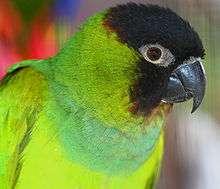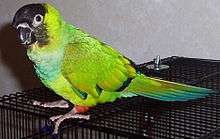Nanday parakeet
| Nanday parakeet | |
|---|---|
 | |
| In Strasbourg, Parc de l'Orangerie | |
| Scientific classification | |
| Kingdom: | Animalia |
| Phylum: | Chordata |
| Class: | Aves |
| Order: | Psittaciformes |
| Family: | Psittacidae |
| Tribe: | Arini |
| Genus: | Aratinga |
| Species: | A. nenday |
| Binomial name | |
| Aratinga nenday (Vieillot, 1823) | |
| Synonyms | |
|
Nandayus nenday | |
The nanday parakeet (Aratinga nenday) also known as the black-hooded parakeet or nanday conure is a medium-small mostly green Neotropical parrot. The bird is native to South America from southeast Bolivia to southwest Brazil, central Paraguay and northern Argentina, from the region known as the Pantanal. Caged birds have been released in some areas and the birds have established self-sustaining populations in Los Angeles, California, San Antonio, Texas, and several areas of Florida (including Pasco County, Pinellas County, Manatee County, Broward County, and Miami-Dade County). Another self-sustaining population has existed for several decades in Israel, near the city of Pardes Hanna-Karkur.
Taxonomy
The nanday parakeet was a member of the monotypic genus Nandayus Bonaparte, 1854 one of the approximately 16 genera of Neotropical parrots of tribe Arini which includes the conures and macaws. However, phylogenetic evidence showed that it is positioned in one of the four groups in the genus Aratinga. When the genus Aratinga was revised and split in four separate genera, this species was included in the current genus Aratinga.[2] This revision was based on earlier studies. According to a mtDNA-based phylogenetic analysis of the genus Aratinga by Ribas & Miyaki (2004), the nanday conure forms a monophyletic group with the sun conure (A. solstitialis), jenday conure (A. jandaya), and golden-capped conure (A. auricapilla). Tavares et al. (2005) in a mitochondrial and nuclear DNA analysis of 29 species representing 25 of 30 genera of Neotropical parrots found the nanday conure's closest relative to be Aratinga solstitialis, the sun conure, and the time of divergence of the species to have been 0.5 to 1.3 mya.
Hybrids of the nanday and sun conures, nanday and jenday conures, and nanday and blue-crowned conures are known.
A prehistoric relative, Aratinga vorohuensis, was described from Late Pliocene fossils found in Argentina.
Description
The nanday parakeet is 32–37 cm (13–15 in) long, weighs 140 g (4.9 oz), and is mostly green in color. Its most distinguishing characteristic, for which it is named, is its black facial mask and beak. It also shows black trailing flight feathers on its wings and has a long tail edged at the end in blue. The upper chest is bluish-green and the lower chest is a paler green. Feathers covering the thighs are red.
Behavior
Food and feeding
The bird feeds on seeds, fruit, palm nuts, berries, flowers and buds. Feral birds will also come to bird feeders. Wild birds primarily use scrub forest and forest clearings around settlements. It frequents open savannah, pastures and stockyards in South America where it is considered a pest in some areas.
Breeding
Nanday parakeets usually find holes in trees to nest in. It lays three or four eggs. After raising its young, all birds will form rather large communal roosts until the next breeding season.
Aviculture



In captivity they make wonderful pets if cared for and socialized properly. They all have distinct personalities and appreciate toys. They require a cage or enclosure that is a minimum of 24 × 24 × 30 inches (60 × 60 × 75 cm) as they are inclined to climb, flap their wings and have long tail feathers. They also like to be outside of their cage at least six hours a day. While they will accept most parrot seed mixes, seed-only diets are nutritionally inadequate, will reduce their lifespan considerably, and may cause them to become underweight. Pellet-based diets with fruits and vegetables offered daily are much preferred. These birds are extremely intelligent and skilled escape artists. Depending on their personality, some Nandays will talk while others will not . They are noted for having a very loud call and are not suited for apartments.
Fearing the birds might escape and become feral agricultural pests, the state of Tennessee, in the United States, bans the keeping of Nanday parakeets as well as monk parakeets.
References
- ↑ BirdLife International (2012). "Aratinga nenday". IUCN Red List of Threatened Species. Version 2013.2. International Union for Conservation of Nature. Retrieved 26 November 2013.
- ↑ DNA-sequence data require revision of the parrot genus Aratinga (Aves: Psittacidae) J.V. Remsen, Jr., Erin E. Schirtzinger, Anna Ferraroni, Luís Fábio Silveira & Timothy F. Wright
- "National Geographic" Field Guide to the Birds of North America ISBN 0-7922-6877-6
- Handbook of the Birds of the World Vol 4, Josep del Hoyo editor, ISBN 84-87334-22-9
- "National Audubon Society" The Sibley Guide to Birds, by David Allen Sibley, ISBN 0-679-45122-6
External links
| Wikimedia Commons has media related to Nandayus nenday. |
